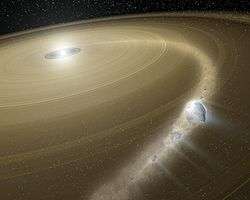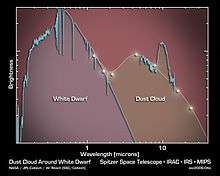G 29-38
Giclas 29-38, also known as ZZ Piscium, is a variable white dwarf star of the DAV, or ZZ Ceti, whose variability is due to large-amplitude, non-radial pulsations, known as gravity waves. It was first reported to be variable by Shulov and Kopatskaya in 1974.[7][8] DAV stars are like normal white dwarfs but have luminosity variations with amplitudes as high as 30%, arising from a superposition of vibrational modes with periods from 100 to 1,000 seconds. Large-amplitude DAVs generally differ from lower-amplitude DAVs by having lower temperatures, longer primary periodicities, and many peaks in their vibrational spectra with frequencies which are sums of other vibrational modes.[9]
 Artist's impression of G29-38 and its debris disk | |
| Observation data Epoch J2000.0 Equinox J2000.0 (ICRS) | |
|---|---|
| Constellation | Pisces |
| Right ascension | 23h 28m 47.74s[1] |
| Declination | +05° 14′ 53.4″[1] |
| Apparent magnitude (V) | 13.03[2] |
| Characteristics | |
| Spectral type | DAV4.4[2] |
| U−B color index | -0.63[2] |
| B−V color index | 0.14[2] |
| V−R color index | 0.0[3] |
| R−I color index | 0.2[3] |
| Variable type | DAV (ZZ Ceti)[2] |
| Astrometry | |
| Radial velocity (Rv) | 15.3 ± 3.0[3] km/s |
| Parallax (π) | 73.4 ± 4.0[2] mas |
| Distance | 44 ± 2 ly (13.6 ± 0.7 pc) |
| Absolute magnitude (MV) | 12.4[4] |
| Details | |
| Mass | 0.70 ± 0.03[5] M☉ |
| Radius | 0.01[6] R☉ |
| Luminosity (bolometric) | 0.002[5] L☉ |
| Surface gravity (log g) | 8.15 ± 0.05[5] cgs |
| Temperature | 11,820 ± 175[5] K |
| Other designations | |
| Database references | |
| SIMBAD | data |
G29-38, like other complex, large-amplitude DAV variables, has proven difficult to understand. The power spectrum or periodogram of the light curve varies over times which range from weeks to years. Usually, one strong mode dominates, although many smaller-amplitude modes are often observed. The larger-amplitude modes, however, fluctuate in and out of observability; some low-power areas show more stability. Asteroseismology uses the observed spectrum of pulsations from stars like G29-38 to infer the structure of their interiors.[9]

Debris disk
The circumstellar environment of G29-38 first attracted attention in the late 1980s during a near-infrared survey of 200 white dwarfs conducted by Ben Zuckerman and Eric Becklin to search for low mass companion stars and brown dwarfs.[10] G29-38 was shown to radiate substantial emission between 2 and 5 micrometres, far in excess of that expected from extrapolation of the visual and near infrared spectrum of the star.[11] Like other young, hot white dwarfs, G29-38 is thought to have formed relatively recently (600 million years ago) from its AGB progenitor, and therefore the excess was naturally explained by emission from a Jupiter-like brown dwarf with a temperature of 1200 K and a radius of 0.15 solar radius.[10][11] However, later observations, including speckle interferometry, failed to detect a brown dwarf.[12]
Infrared observations made in 2004 by NASA's Spitzer Space Telescope indicated the presence of a dust cloud around G29-38, which may have been created by tidal disruption of an exocomet passing close to the white dwarf.[13] This may mean that G29-38 is still orbited by a ring of surviving comets and, possibly, outer planets. This is the first observation supporting the idea that comets persist to the white dwarf stage of stellar evolution.[14]
References
- Revised Coordinates and Proper Motions of the Stars in the Luyten Half-Second Catalog, Gáspár Á. Bakos, Kailash C. Sahu, and Péter Németh, Astrophysical Journal Supplement 141, #1 (July 2002), pp. 187–193. CDS ID I/279 Archived 2007-01-06 at the Wayback Machine.
- The general catalogue of trigonometric parallaxes, W. F. van Altena, J. T. Lee, E. D. Hoffleit, New Haven, CT: Yale University Observatory, c1995, 4th ed., completely revised and enlarged. CDS ID I/238A.
- "V* ZZ Psc". SIMBAD. Centre de données astronomiques de Strasbourg. Retrieved December 11, 2008.
- From apparent magnitude and parallax.
- Table 1, The Formation Rate and Mass and Luminosity Functions of DA White Dwarfs from the Palomar Green Survey, James Liebert, P. Bergeron, and J. B. Holberg, The Astrophysical Journal Supplement Series 156, #1 (January 2005), pp. 47–68, doi:10.1086/425738, Bibcode: 2005ApJS..156...47L.
- §1, The Dust cloud around the White Dwarf G 29-38. 2. Spectrum from 5-40 microns and mid-infrared variability, William T. Reach, Carey Lisse, Ted von Hippel, and Fergal Mullally, Astrophysical Journal, in press, Bibcode: 2008arXiv0810.3276R.
- O. S. Shulov and E. N. Kopatskaya, Astrofizika 10, #1 (January–March, 1974), pp. 117–120. Translated into English as Variability of the white dwarf G 29-38, Astrophysics, 10, #1 (January, 1974), pp. 72–74. DOI 10.1007/BF01005183.
- G 29-38 and G 38-29: two new large-amplitude variable white dwarfs, J. T. McGraw and E. L. Robinson, Astrophysical Journal 200 (September 1975), pp. L89–L93.
- Observational limits on companions to G29-38, S. J. Kleinman, R. E. Nather, D. E. Winget, J. C. Clemens, P. A. Bradley, A. Kanaan, J. L. Provencal, C. F. Claver, T. K. Watson, K. Yanagida, J. S. Dixson, M. A. Wood, D. J. Sullivan, E. Meistas, E. M. Leibowitz, P. Moskalik, S. Zola, G. Pajdosz, J. Krzesinski, J.-E. Solheim, A. Bruvold, D. O'Donoghue, M. Katz, G. Vauclair, N. Dolez, M. Chevreton, M. A. Barstow, S. O. Kepler, O. Giovannini, C. J. Hansen, and S. D. Kawaler, Astrophysical Journal 436, #2 (December 1994), pp. 875–884.
- A low-temperature companion to a white dwarf star, E. E. Becklin & B. Zuckerman, Nature 336 (Dec. 15, 1988), pp. 656-658
- Excess infrared radiation from a white dwarf - an orbiting brown dwarf? B. Zuckerman & E. E. Becklin, Nature 330, (Nov. 12, 1987), pp. 138-140
- Keck Speckle Imaging of the White Dwarf G29-38: No Brown Dwarf Companion Detected, Marc J. Kuchner, Christopher D. Koresko, and Michael E. Brown, The Astrophysical Journal 508, #1 (November 20, 1998), pp. L81–L83. doi:10.1086/311725. Bibcode: 1998ApJ...508L..81K.
- The Dust Cloud around the White Dwarf G29-38, William T. Reach, Marc J. Kuchner, Ted von Hippel, Adam Burrows, Fergal Mullally, Mukremin Kilic, and D. E. Winget, Astrophysical Journal 635, #2 (December 2005), pp. L161–L164.
- NASA's Spitzer Finds Possible Comet Dust Around Dead Star, NASA press release, January 11, 2006.
External links
- Britt, Robert Roy (7 February 2002). "Tales From the Stellar Grave: Born Again Planets". Space.com. Archived from the original on 2008-03-31. Retrieved 2006-12-24.